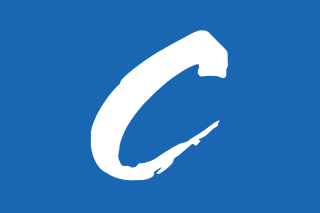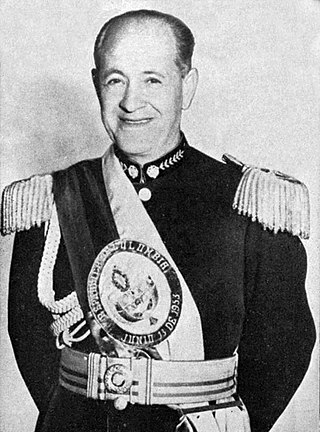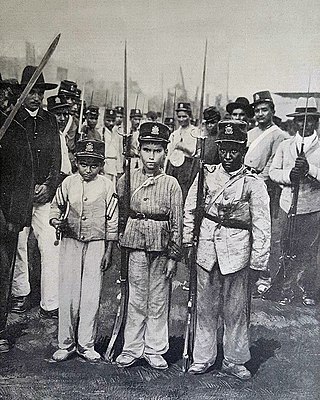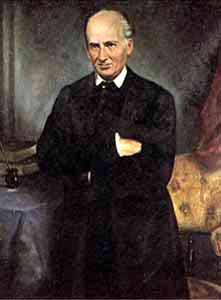Contents
This article relies largely or entirely on a single source .(November 2024) |
| |||||
| Decades: | |||||
|---|---|---|---|---|---|
| See also: | |||||
Events of 1901 in Colombia .
This article relies largely or entirely on a single source .(November 2024) |
| |||||
| Decades: | |||||
|---|---|---|---|---|---|
| See also: | |||||
Events of 1901 in Colombia .

Luis Mariano Ospina Pérez, commonly known as Mariano Ospina Pérez, was a Colombian politician and a member of the Colombian Conservative Party. He served as the 17th President of Colombia between 1946 and 1950.

Tomás Cipriano Ignacio Maria de Mosquera y Figueroa Arboleda Salazar, Prieto de Tovar, Vergara, Silva, Hurtado de Mendoza, Urrutia y Guzmán was a Colombian general, political figure, and slaveholder. He was president of Colombia four times. The first time was as president of Republic of New Granada from 1845 to 1849. During the Colombian Civil War of 1860–1862 he led liberal forces in a civil war against conservative factions. After the liberals won, a new, federalist constitution was implemented, which established a two-year presidency, and the nation renamed the United States of Colombia. Mosquera served twice as president of the new government. From 1861 to 1862 he served in a non-elected, interim manner, while the constitution was written. From 1862 to 1864 he served in an elected manner. He had a fourth term from 1866 to 1867. Due to the liberal reforms carried out under his leadership, he is considered one of the most important persons in Colombian history of the 19th century.

Guillermo León Valencia Muñoz was a Colombian politician, lawyer and diplomat who served as the 21st President of Colombia from 1962 to 1966.

The Colombian Conservative Party is a conservative political party in Colombia. The party was formally established in 1849 by Mariano Ospina Rodríguez and José Eusebio Caro.

José Cipriano Castro Ruiz was a high-ranking officer of the Venezuelan military, politician and the president of Venezuela from 1899 to 1908. He was the first man from the Venezuelan Andes to rule the country, and was the first of four military strongmen from the Andean state of Táchira to rule the country over the next 46 years.

Gustavo Rojas Pinilla was a Colombian army general, civil engineer and politician who ruled as 19th President of Colombia in a military dictatorship from June 1953 to May 1957.

El Bogotazo was a massive outbreak of rioting after the assassination in Bogotá, Colombia of Liberal leader and presidential candidate Jorge Eliécer Gaitán on 9 April 1948 during the government of President Mariano Ospina Pérez. The 10-hour riot left much of downtown Bogotá destroyed.

The Thousand Days' War was a civil war fought in Colombia from 17 October 1899 to 21 November 1902, at first between the Liberal Party and the government led by the National Party, and later – after the Conservative Party had ousted the National Party – between the liberals and the conservative government. Caused by the longstanding ideological tug-of-war of federalism versus centralism between the liberals, conservatives, and nationalists of Colombia following the implementation of the Constitution of 1886 and the political process known as the Regeneración, tensions ran high after the presidential election of 1898, and on 17 October 1899, official insurrection against the national government was announced by members of the Liberal Party in the Department of Santander. Hostilities did not begin until the 11th of November, when liberal factions attempted to take over the city of Bucaramanga, leading to active warfare. It would end three years later with the signing of the Treaty of Neerlandia and the Treaty of Wisconsin. The war resulted in a Conservative victory, and ensured the continued dominance of the Conservative Party in Colombian politics for another 28 years. Colombia's political structure as a unitary state has not been challenged since.

The Ecuadorian–Colombian War was a series of armed conflicts waged between the current republics of Colombia and Ecuador between 1862 and 1863.

The battle of Aguadulce took place during the Colombian Thousand Days War, between Liberals and Conservatives. It occurred between February 23 and August 27, 1901, and ended in an overwhelming victory on the part of the Liberal army under the command of General Benjamin Herrera over the Conservative army based in the city of Aguadulce under the command of General Francisco Castro.

José Arsenio Vicente del Carmen de Obaldía y Orejuela was the 7th Vice President of New Granada, and as such served as Acting President in two occasions.

José María Dionisio Melo y Ortiz was a Colombian general and political figure who fought in the South American wars of independence, and who rose to power and briefly held the presidency of Colombia in 1854. Of Pijao ancestry, he is considered the country's first and only indigenous president.

Mariano Ospina Rodríguez was a Colombian politician, journalist and lawyer, founder of the Colombian Conservative Party and later President of Colombia between 1857 and 1861 during the Granadine Confederation.

Juan Ignacio Paulino Ramírez Calzada, more commonly known as Ignacio Ramírez, was a 19th century Mexican liberal intellectual and statesman. He was known for publishing various newspapers championing progressive causes, and he would often use the pen name El Nigromante,. He served in more than one presidential cabinet and would go on to become president of the supreme court.

Rafael Victor Zenón Uribe Uribe was a Colombian lawyer, journalist, and general in the liberal party rebel army.

The Battle of the Magdalena River, also known as the Battle of Los Obispos or the Battle of Gamarra, was the first major battle of the Thousand Days' War. It took place on the Magdalena River on 24 October 1899, near the town of Gamarra, Magdalena, Colombia. The Liberal Party rebelled against the Conservative government of Manuel Antonio Sanclemente on 17 October 1899 and attempted to seize the Magdalena River in a bid to sever riverine transportation to Bogotá. A rebel flotilla composed of converted passenger steamships and a dredge temporarily impeded Conservative advances down the river, but on the night of 24 October, two Conservative gunboats under General Diego de Castro destroyed the rebel flotilla.

The Battle of Bucaramanga took place during the Santander Campaign of the Thousand Days' War in Colombia. It ended on 13 November 1899 with a victory of the Conservative forces over the Liberals after a two day battle. After an earlier defeat in a naval engagement on the Magdalena River, the Liberal rebels skirmished with the Conservative government around Piedecuesta in late October. The Conservative forces under General Juan B. Tovar conducted a fighting retreat to Bucaramanga.

The Battle of Peralonso, also known as the Battle of La Amarilla or the Battle of La Laja, was a major battle in the Santander Campaign of the Thousand Days' War in Colombia. It was fought between the Conservative government and the Liberal rebels between 15 and 16 December 1899, ending in an important Liberal victory. The Liberal rebels had suffered a series of major defeats culminating in the failed attack on Bucaramanga on 13 November. Afterward, the Liberal forces splintered into three autonomous forces, led by Rafael Uribe Uribe, Benjamín Herrera, and Justo L. Durán, but they first regrouped in Cúcuta. The autonomous rebel armies shifted to new positions on and around the heights of Cerro Tasajero, north of Cúcuta and close to the border with Venezuela.

The Battle of Carazúa was a battle of the Thousand Days' War. It took place on 13 September 1901 between Colombia and Venezuela.
The Venezuelan civil wars were a long series of conflicts that devastated the country during most of the 19th century.